


 



  
|

Taxonomy
and description
Definition
How can land use planning encourage less motorised personal
travel?
Technology
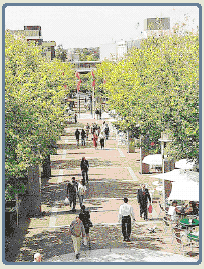 Definition Definition
Encouraging less motorised personal travel through land use involves
the planning of new land use development and the management of existing
land use in such a way as to bring origins and destinations closer together
in order to help reduce private transport trips. This is normally done
by increasing development densities or by
organising the mix of lad use types, or both. Land use policy can also
encourage a modal shift to public transport (see 'Encouraging
public transport use through land use planning').
How can land use planning encourage less personal motorised travel?
Land use patterns affect travel behaviour. A variety of land use factors
affect travel patterns including density, land use mix, roadway connectivity
and design, parking facility design, and building design. Certain types
of land use patterns are accessible by multiple modes, which reduces per
capita car use, while others are car- orientated, which increases private
car use. There are several strategies which involve changing land use
patterns to increase multi-modal accessibility and reduce car use. (Online
TDM encyclopaedia).
The full range of ways in which land use planning can encourage less
personal motorised travel is as follows (TUE, p58). The list includes
all types of land use instruments: the first two are covered in this section,
the remaining six in other sections as shown.
1. increasing development densities - higher densities may encourage
shorter journeys and, thus, the use of walking and cycling (and may help
to make public transport more viable, see 3 below);
2. altering the development mix - a better mix of uses can improve accessibility
and, hence, reduce the need to travel;
3. concentrating dense developments within transport corridors - where
public transport can provide a viable alternative to the use of cars (see
Encouraging Public Transport Use Through Land Use
Planning);
4. reducing parking standards
- this probably offers the single most direct impact on levels of car-use
and can be used in trip-end restraint (see Parking
Standards);
5. increasing developers' contributions for transport infrastructure,
including public transport. Alternatively, the provision of public transport
services can be required as part of the process of obtaining planning
approval for new developments; (see Developer Contributions);
6. requiring commuted payments - these are a special type of developer
contribution in which the normal requirements for private parking provision
are waived in return for payment to a local authority of a charge per
space, so that the Local Authority can make provision in public car parks
or promote park-and-ride schemes (see Commuted Payments);
7. promoting travel-reduction ordinances/company transport plans - travel-reduction
ordinances are used in the US and the Netherlands to require developers
to produce a plan specifying ways in which they will reduce car-use to
their development; this would require legislation in the UK. As an alternative,
voluntary company travel plans
could be developed.
How can land use density and land use mix encourage
less personal motorised travel? (based on Online TDM Encyclopaedia).
Density refers to the number of people or jobs in a given area. Mix refers
to how land uses are arranged in relation to each other. If common destinations
are located close together, this type of mix is sometimes known as 'clustering'.
An example of clustering is illustrated in the figure below:
A. This shows a conventional suburban development with buildings
surrounded by parking and isolated from each other. There are often no
paths connecting the buildings or sidewalks along the streets. Only car
transport can effectively serve such destinations.
B. This shows the same buildings sited so they are clustered together
and orientated toward the street, with main entrances that connect directly
to the sidewalk rather than being located behind parking. This creates
convenient pedestrian access between them, for example, making it easier
for an employee in an office to visit an adjacent building, with a bank
or shop for example (and for employees from two different buildings potentially
to car share).
C. This shows eight buildings clustered around a park. As the cluster
increases in size the efficiency of pedestrian improvements, car sharing
and public transport services also increase, due to economies of scale.
D. This shows the eight-office building integrated into a park or campus,
creating more convenient and attractive pedestrian connections between
the buildings, further improving access and supporting transportation
alternatives. It also creates a more enjoyable environment for employees
and visitors compared with isolated buildings surrounded by parking.
Clustering At the Local Scale
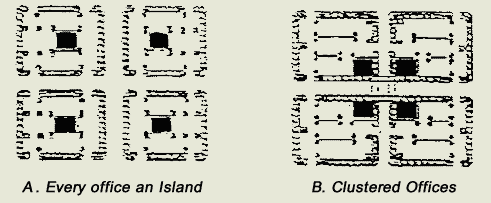
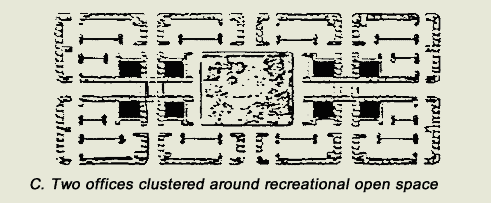
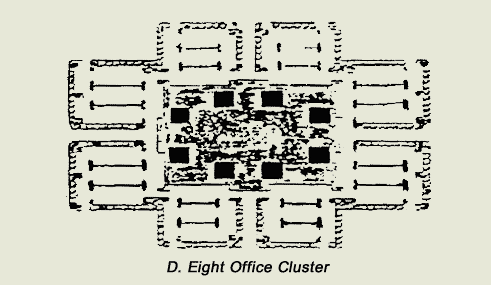
Source: Online TDM Encyclopaedia
Density and mix can have significant impacts on travel demand and travel
patterns through the following mechanisms:
- Accessibility: The number of potential destinations located within
a geographical area tends to increase with population and employment
density, reducing travel distances and the need for private travel.
For example, in low-density areas a school may serve hundreds of square
miles, requiring most students to travel by motor vehicle. In higher
density areas, schools may serve just a few square miles, reducing average
travel distances and allowing more students to walk or cycle. Similarly,
average travel distances for errands, commuting and business-to-business
transactions can decline with density.
- Transport choice: Increased density tends to increase the number of
transport options available in an area due to economies of scale. Higher
density areas tend to have better pedestrian and bicycle facilities
and better public transport service because increased demand makes them
more cost-effective.
As a result of these factors, higher density and clustered land use
mix together tend to reduce per capita car ownership and use, and increased
use of alternative modes (Jack Faucett Associates and Sierra Research,
1999).
International studies indicate that increased urban density significantly
reduces per capita vehicle travel, as illustrated in the figure below
(Newman, et al, 1997; Kenworthy and Laube, 1999). This occurs in both
higher-income and lower-income regions.
Urban Density and Motor Vehicle Travel (Kenworthy and Laube, 1999)
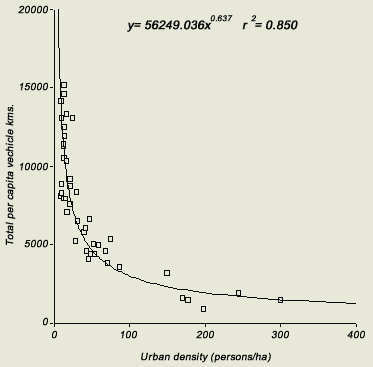
Each point marked on the graph represents a major international city.
Per capita vehicle use tends to decrease with density.
Holtzclaw (1994) found that average vehicle ownership, vehicle travel,
and vehicle expenditure per household decline with increasing residential
densities and proximity to public transport, holding constant other demographic
factors such as household size and income.
Technology
This policy instrument is not dependent upon technology.

|




